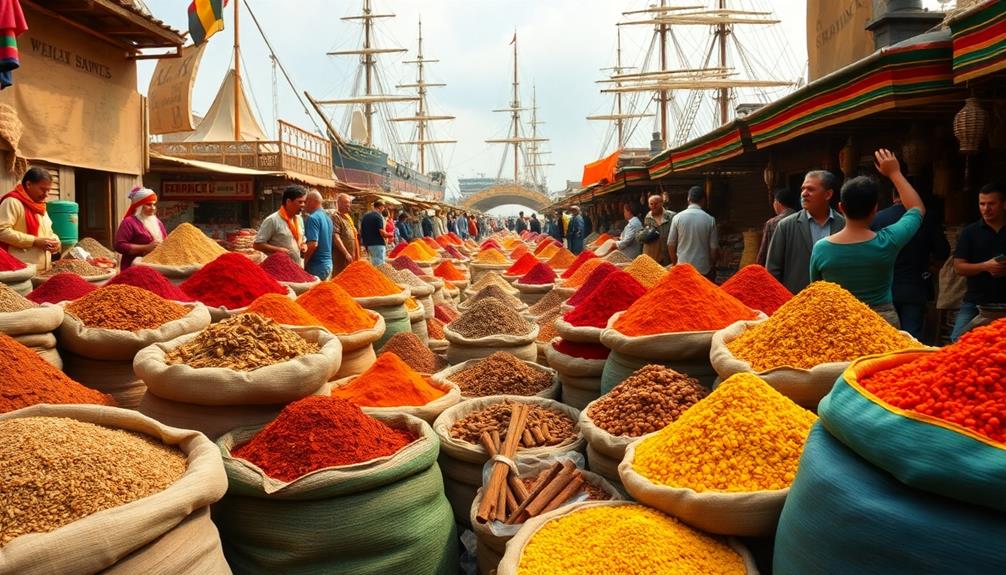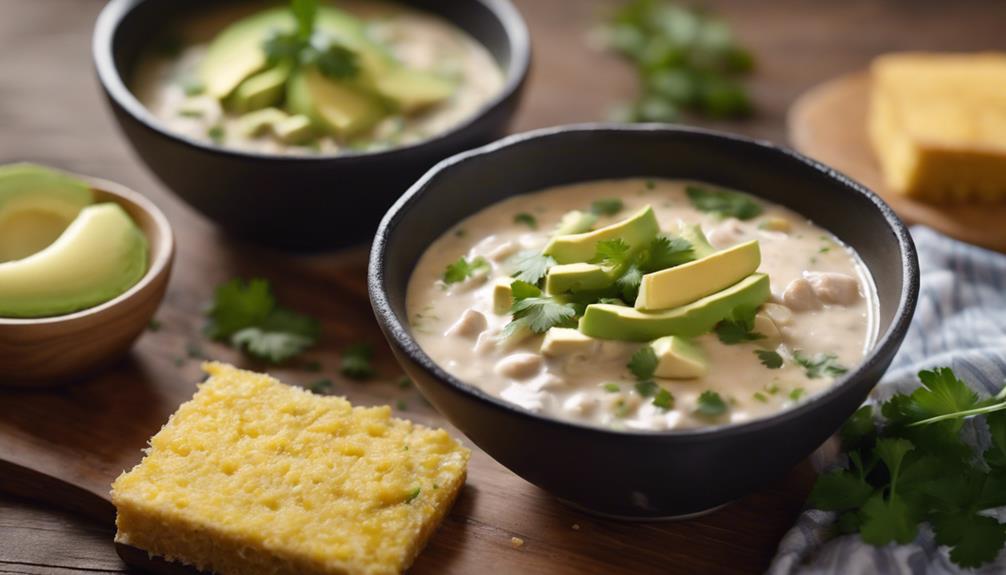Spices have profoundly shaped world history by driving exploration, trade, and conflict. You'd notice that ancient trade routes for spices connected distant lands like India, Rome, and China. Wealthy nations competed fiercely for control, sparking the Age of Discovery. This led to fierce conflicts over spice-rich territories among European powers. As you explore, you'd see how spices revolutionized European diets, making exotic flavors a status symbol. Today, the spice trade faces modern challenges, but it still influences diets and economies. The rich history of spices reveals so much more about their impact on global trade and culture.
Key Takeaways
- The spice trade initiated around 1000 BCE significantly influenced economic dynamics, leading to competition among nations for control and wealth.
- The Age of Discovery was driven by European nations seeking direct access to spices, reshaping global trade routes and colonial ambitions.
- Spices transformed European diets, enhancing culinary practices and establishing status symbols among the elite during the Renaissance.
- Modern challenges, including climate change and ethical sourcing, are reshaping the spice industry and impacting traditional cultivation methods.
- The rise of the wellness industry has spurred demand for spices like turmeric, aligning consumption trends with health-oriented lifestyles.
Origins of the Spice Trade
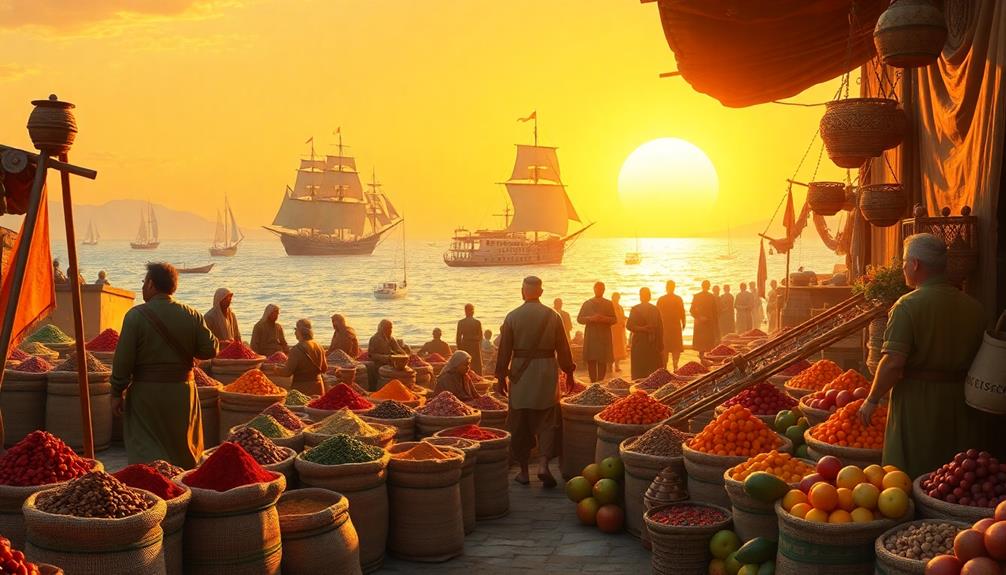
The origins of the spice trade can be traced back to around 1000 BCE, when cinnamon and pepper made their way from India and Indonesia to the bustling markets of Egypt. This marked the beginning of a vibrant spice trade, with Arab merchants dominating the industry for nearly a thousand years. They controlled essential transport routes to Red Sea ports, establishing a monopoly that allowed them to thrive.
The diverse spices available in different regions, much like the rich flavors in Brazilian cuisine, contributed to the allure of the spice trade, enticing merchants and consumers alike.
By 120 BCE, Greek sailors began to harness monsoon winds, challenging the Arab monopoly and opening up broader trading networks. This shift greatly impacted the spice trade, as more merchants ventured to connect with India, the heart of spice production.
With the Roman Empire's control over Egypt starting in 30 BCE, the spice industry experienced a boom, with around 120 ships sailing to India annually.
As trade routes expanded around 1 CE, they linked Rome to China via India, cementing India's role as the central hub for global spice distribution.
The interplay between Arab merchants, Greek sailors, and the Roman Empire shaped the intricate web of the spice trade, laying the groundwork for its lasting influence on world history.
Economic Impact of Spices
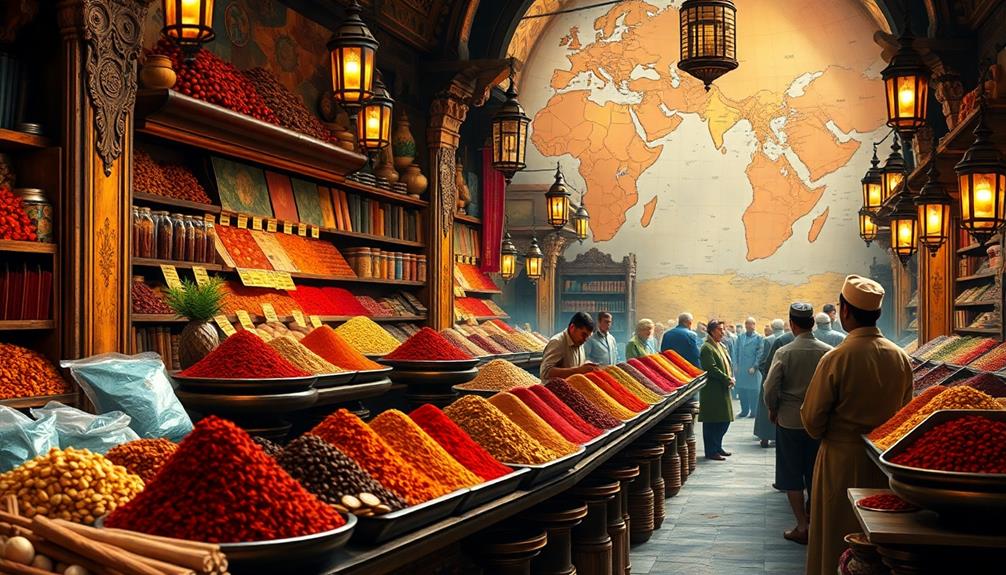
Spices have long been a driving force behind economic growth and social change, shaping entire societies through their value. The spice trade not only generated immense wealth for those controlling the spice routes but also sparked conflicts and innovations that changed history. For instance, the rich flavors in traditional Indian dishes like Mushroom Masala illustrate how spices can enhance culinary experiences and drive demand across cultures.
- A pound of nutmeg in the 1300s equated to seven fattened oxen, even surpassing gold in worth.
- High tariffs in Venice during the mid-13th century led Europeans to seek alternatives, pushing them to explore direct trade routes.
- The demand for spices during the Renaissance greatly contributed to the rise of the middle class.
As spices flowed from the Middle East through complex maritime trading networks, they became integral to European economies. The exorbitant prices charged for these luxury goods created a race among powerful nations to control the spice trade.
This competition fueled exploration and conflict, as nations sought to establish dominance over the spice route. The entry of American companies in the 18th century shifted trade dynamics, allowing direct dealings with Asian growers and reducing European monopolistic power.
As a result, spices not only enriched individual fortunes but also transformed societies and economies across continents.
Age of Discovery

As European nations sought to control the lucrative spice trade, a new era of exploration emerged, known as the Age of Discovery.
You'd see explorers like Vasco da Gama maneuvering around Africa to reach India in 1498, which opened direct maritime trade routes and diminished Arab control over spices. This shift notably altered the spice trade landscape, igniting fierce competition among nations. The quest for spices also paralleled the discovery of new culinary delights, such as Chilaquiles, showcasing how the desire for flavor influenced trade and cultural exchanges.
The quest for spices fueled conflicts, especially over the coveted Spice Islands in Indonesia, as countries like Spain, England, and the Dutch vied for dominance. These rivalries lasted for about 200 years, shaping global power dynamics.
Curiously, Christopher Columbus's discovery of the Americas in 1492 was also driven by the search for spices, showcasing the far-reaching implications of spice demand on exploration.
With the establishment of East India Companies by the Dutch and English, the spice trade dynamics evolved further. These companies challenged the Portuguese Empire's dominance, leading to a more decentralized and competitive market.
The Age of Discovery, fueled by the insatiable appetite for spices, not only transformed economies but also laid the groundwork for the modern world.
Colonial Conflicts Over Spices
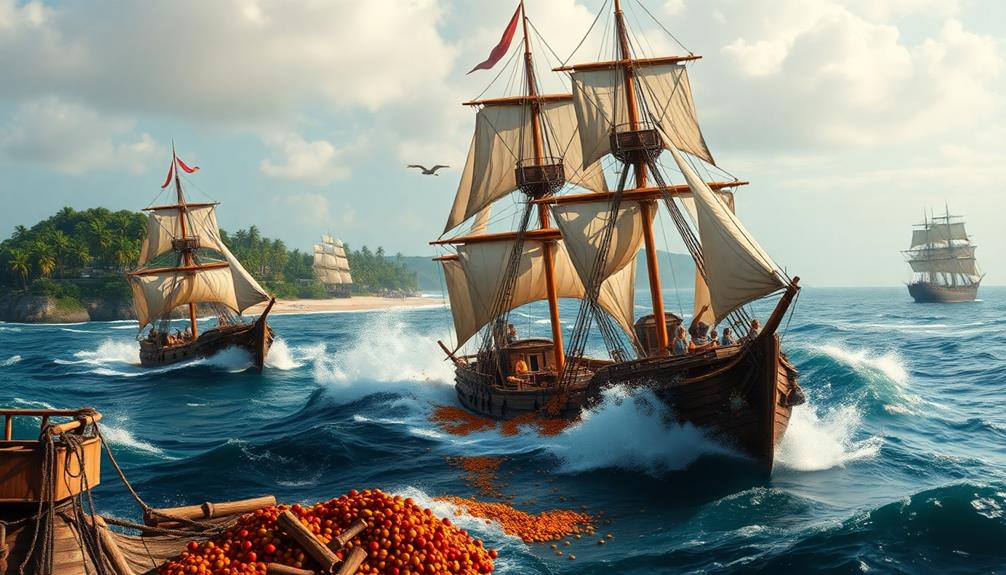
Conflicts over spice trade routes erupted into intense warfare among European nations from the 15th to the 17th centuries. As the Renaissance sparked a rising middle class with a growing appetite for spices, competition escalated. Territories rich in spices like nutmeg and cloves became hotbeds of conflict, much like the diverse flavors found in traditional dishes such as Red-Braised Pork Belly.
The island of Run, famous for its nutmeg trees, saw England trade the island for several colonies, including Manhattan.
Spanish and Portuguese forces clashed over the lucrative clove trade, illustrating the fierce rivalry for spice dominance.
The Dutch engaged in fierce battles with the English for control over nutmeg in Indonesia.
These conflicts weren't just about spices; they shaped global trade and led to expansive territorial claims by colonial powers. Nations sought to secure their footholds in spice-rich regions, forever altering the geopolitical landscape.
The quest for spices resulted in the establishment of colonies, shifting the balance of power in Europe and beyond. As these European nations fought for supremacy, they laid the groundwork for modern global trade routes, demonstrating that the allure of spices could ignite wars and reshape the world.
Transformation of European Diets

Imagine walking through a bustling medieval market, where the vibrant colors and intoxicating aromas of exotic spices fill the air. You'd witness the transformation of European diets, as spices became indispensable to culinary practices. No longer were meals bland; instead, they burst with flavors that tantalized the senses.
Pepper, cinnamon, and cloves not only enhanced taste but also signified wealth, with the elite flaunting their spice-laden dishes as a status symbol. In many cultures, spices played a significant role in traditional dishes, much like how Muamba De Galinha embodies the rich flavors of Angolan cuisine, showcasing the importance of spices in both taste and cultural identity.
This growing interest in spices ignited a culinary revolution, prompting changes in cooking techniques and ingredients. Cooks began experimenting with preservation methods, extending the shelf life of meats and perishables, which proved essential during harsh winters.
As the demand for these spices soared, it fostered trade relationships that connected Europe with distant lands, inspiring exploration and reshaping society.
The allure of spices wasn't just about taste; it was also about survival and status. Their impact on European diets was profound, as they transformed how people viewed food and influenced the very fabric of social life.
As you savor the flavors of these spices today, you're tasting a legacy that forever changed the culinary landscape of Europe.
Modern Challenges in Spice Trade

The spice trade, once a symbol of luxury and adventure, now faces considerable modern challenges that threaten its sustainability and integrity. Climate change, food fraud, and shifting demands for ethical sourcing push the industry into uncertain territory.
As you explore the complexities of today's spice market, consider these critical issues:
- Extreme weather events greatly impact spice production, affecting crops like cloves and nutmeg. The challenges of climate change mirror those faced by farmers growing Nettle and Potato Soup, who rely on stable weather patterns for their harvests.
- Rising deforestation jeopardizes local ecosystems, creating sustainability challenges. Advanced detection technologies are essential in fighting food fraud that plagues high-value spices.
The legacy of Arab traders who once expertly navigated the spice routes feels distant as you witness the current landscape.
In response to the growing demand for organic spice mixtures, the industry must embrace sustainable farming practices. This shift not only helps farmers adapt but also guarantees that spices retain their integrity.
As you ponder the future, remember that the fate of the spice trade lies in balancing tradition with modern ethical sourcing and innovative solutions to combat climate change. Only then can the rich history of spices continue to thrive in the contemporary world.
Evolving Consumption Trends
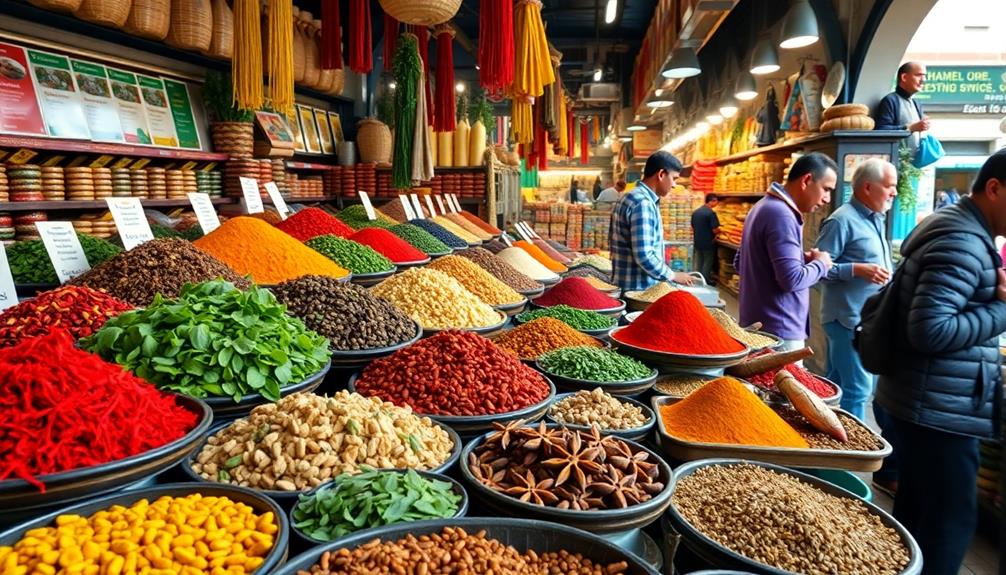
Recent trends in spice consumption reveal a remarkable shift towards healthier eating habits, with many people increasingly turning to spices for their nutritional benefits. Turmeric, in particular, is gaining popularity, especially in Europe, where its consumption is growing at nearly 6% annually. The wellness industry plays a significant role in this surge, as you seek natural remedies for anti-inflammatory issues and joint health.
Changing consumer habits show a growing appreciation for spices, evolving from traditional flavorings to healthier, spice-based alternatives. This shift has led to increased demand for organic spices, prompting farmers to adopt sustainable practices in their cultivation methods. In response to this demand, many farmers have started to use natural fertilizers and pest control methods, as well as avoiding the use of synthetic chemicals. This not only benefits the environment, but also results in higher quality spices that are free from harmful residues. For example, a tasty spinach dip recipe can now be elevated with the use of fresh, organic spices that provide a more robust and complex flavor profile.
Here's a look at the evolving spice consumption trends:
| Spice | Key Benefits | Culinary Applications |
|---|---|---|
| Turmeric | Anti-inflammatory properties | Smoothies, curries |
| Cinnamon | Blood sugar regulation | Oatmeal, baked goods |
| Ginger | Digestive aid | Teas, stir-fries |
| Black Pepper | Enhances nutrient absorption | Seasoning, marinades |
As you explore innovative uses for spices beyond culinary applications, the health benefits of these natural ingredients continue to inspire new industries.
Future of Spice Industry

Looking ahead, the future of the spice industry is shaped by both challenges and opportunities. Climate change poses significant threats, impacting production through extreme weather and changing growing conditions. However, the global spice market is evolving, responding to rising consumer demand for sustainable products. Traditional cuisines, such as those featuring Kue Putu, highlight the importance of spices in enhancing flavors and cultural significance.
- Innovations in food-fraud detection guarantee authenticity and purity.
- There's an increasing focus on high-value products like turmeric, driven by health and wellness trends.
- Spice companies are adapting their sourcing and farming practices to promote sustainability.
As you engage with the spice industry, you'll find that balancing quality and sustainability is vital. Companies are implementing new technologies, such as infrared spectroscopy and smartphone scanners, to combat fraud and maintain supply chain integrity.
The push for organic and sustainable spices aligns with consumer expectations, making it imperative for businesses to innovate continually.
The future holds promise for spices that not only tantalize your taste buds but also contribute to your well-being. By prioritizing authenticity and sustainability, spice companies can thrive in a changing landscape while meeting the demand for healthier, high-value products.
Frequently Asked Questions
How Did Spices Influence World History?
Spices influenced world history by driving exploration and trade. You'll see how nations sought wealth, established empires, and engaged in conflicts over routes, ultimately reshaping global commerce, cultures, and culinary practices that persist today.
Why Are Spices Important in History?
Spices are essential in history because they drove trade, shaped economies, and influenced cultures. You can see their impact in culinary practices, global connections, and even conflicts that defined nations and relationships throughout time.
What Was the Impact of the Spices?
You might not realize it, but spices stirred wars, sparked explorations, and altered diets. They transformed simple meals into gourmet experiences, reshaped economies, and fueled empires, forever changing the world you live in today.
How Did Herbs and Spices Play a Role in History?
Herbs and spices shaped history by driving trade, influencing diets, and inspiring exploration. Their value fueled economic growth and sparked conflicts over territories, ultimately transforming cultures and establishing connections across distant lands. You'd feel their impact everywhere.
Conclusion
In exploring how spices changed world history, you see their power to shape economies, fuel explorations, and spark conflicts. You recognize spices not just as flavors but as catalysts of transformation, enriching diets and cultures alike. As you look to the future, you realize that while challenges loom, the spice trade continues to evolve, offering endless possibilities for innovation and connection. Embrace the journey of spices, for they've always been more than just seasoning; they've been history on your plate.
